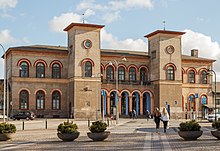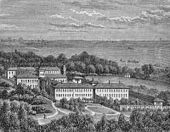Roskilde
| Roskilde | ||||
|
||||
| Basic data | ||||
|---|---|---|---|---|
| State : |
|
|||
| Region : | Sjælland | |||
|
Municipality (since 2007) : |
Roskilde | |||
| Coordinates : | 55 ° 39 ′ N , 12 ° 5 ′ E | |||
| Founded: | 998 AD | |||
|
Population : (2020) |
51,262 | |||
| Postal code : | 4000 | |||
| Website: | www.roskilde.dk | |||
 Sunset over the cathedral |
||||
The Danish city of Roskilde [ ˈʁʌskilə ] is located on the Baltic Sea island of Sjælland (Zealand) about 30 km west of Copenhagen and has been a city in the Sjælland region (Zealand region) since the administrative reform of 2007 . The name should be derived from "Roars Kilde" = "Roars source". King Roar is a legendary figure. Roskilde was once the royal city and played an important role in the history of Denmark . The city is best known internationally for the annual Roskilde Music Festival .
geography
The city center stretches on a slope between the Roskildefjord and the København – Fredericia railway line . The center is between the train station and the cathedral . The main shopping street is the pedestrian zone , which consists of the Algade-Stændertorv-Skomagergade street. The cathedral is located near Stændertorv, the central market square ("Ständemarkt") with a weekly market on Wednesdays and Saturdays.
history
Roskilde was probably founded in 998 as the successor to the nearby Gammel Lejre . After Adam von Bremen it was called Roschald . Until 1443 it was the capital of Denmark and until the introduction of the Reformation in 1536 it was also the seat of the bishops of Zealand . In 1658 the Peace of Roskilde was agreed here. In 1972 Roskilde became a university town.
Development of the population of the municipality (January 1st) :
|
|
|
Since 2007, the “old” Roskilde municipality has been merged with the municipalities of Gundsø Kommune and Ramsø Kommune to form the “new” Roskilde Municipality . The new municipality has 87,914 inhabitants with an area of 212 km² (as of January 1, 2020). It is part of the Sjælland region .
Town twinning
See also: Roskilde Parish Partnerships
Culture and sights
Buildings
The Roskilde Cathedral was founded in 1995 by the UNESCO for World Heritage declared. Begun in 1170 in Romanesque style and rebuilt in Gothic style since 1200 , it is the last resting place of 20 Danish kings and 17 queens. For this reason, several royal mausoleums were added to the building, which changed the shape of the building over time. The two west towers date from the 14th century. The gilded Antwerp reredos (around 1550–1560) and the artistically carved choir stalls (1420) are among the most precious pieces of the rich interior decoration .
The palace next to the cathedral has been the bishopric again since 1923.
The train station, built in 1847, is reminiscent of the Galleria Borghese in Rome.
archeology
In the mud of the fjord of Roskilde, which is only a meter deep , is the most important ship cemetery of Skuldelev , where the remains of numerous dragon boats ( long ships ) from the Viking Age came to light: five Viking ships in 1962 , in 1996, when the Roskilde Viking Ship Museum had long been established and expanded , nine more ships came to light. One of them is 36 m long, making it the longest dragon boat find ever. In the Viking Ship Museum in Roskilde, the finds are preserved and partially exhibited. Scientists and craftsmen research and test the old manufacturing techniques and then make seaworthy reconstructions of the ships on the basis of computer-aided 3D models, e.g. B. a replica of the Skuldelev 2 , a 28 m long ship found in 1962. The replica was completed in 2004 and set sail as Havhingsten fra Glendalough .
The passage grave at Øm , one of the best preserved in Denmark, is located southwest of the village .
Late Antwerp reredos in the cathedral
Regular events
The city is known abroad, among other things, for the annual Roskilde Music Festival , which annually attracts around 100,000 people and is one of the largest European music festivals.
Economy and Infrastructure
Established businesses
The Nycomed company has a location here.
Public facilities
Since 1816 the Sct. Hans Hospital, a psychiatric hospital, in Roskilde.
education
In the course of the student movement of 1968 and the demands for greater opportunities for students to influence the education system - initially as an experimental implementation of these ideas - the University of Roskilde ( Roskilde Universitetscenter ( RUC )) was conceived. In 1972 this was opened as a particularly progressive and innovatively planned facility, which was intended to counter the “classic” university teaching and learning methods with a new concept. The basic principle consists in the active organization of teaching by the students and their independent and self-responsible handling of their training. Other core components are working in small groups, interdisciplinarity and discussions on democratic decision-making.
Since 2009 there is a democratic school in Roskilde (Den Demokratiske Skole).
sons and daughters of the town
- Hans Christensen Sthen (1544–1610), pastor, author, hymn poet
- Erasmus Bartholin (1625–1698), scientist
- Gottfred Matthison-Hansen (1832–1909), composer
- Niels Alfred Andersen (1843–1900), teacher, businessman, civil servant and inspector of Greenland
- Aksel Schiøtz (1906–1975), singer and music teacher
- Lise Nørgaard (* 1917), journalist, writer and screenwriter
- Otto Franker (1921–1988), jazz and entertainment musician
- Willy Rathnov (1937-1999), actor
- Reno Olsen (* 1947), racing cyclist
- Michael Marcussen (* 1955), racing cyclist
- Ole Christian Madsen (* 1966), film director
- Thomas Sunn Pedersen (* 1970), plasma physicist
- Nicolai Bo Larsen (* 1971), cyclist
- Theo Jørgensen (* 1972), poker player
- Jan Magnussen (* 1973), racing car driver
- Jon Dahl Tomasson (born 1976), football player
- Jesper Christiansen (* 1978), soccer goalkeeper
- Peter Madsen (* 1978), football player
- Carsten Mogensen (* 1983), badminton player
- Natasha Thomas (* 1986), singer
- Freja Beha Erichsen (* 1987), photo model
- Christian Gytkjær (* 1990), football player
- Christian Kreutzfeldt (* 1991), cyclist
- Kevin Magnussen (* 1992), racing car driver
- Signe Sjølund (* 1992), handball player
Web links
- Official homepage of the municipality (Danish, English)
- VisitRoskilde Tourist Information (Danish, German, English)
- University of Roskilde (Danish, English)
Individual evidence
- ↑ a b Statistics Banks -> Befolkning og valg -> BY1: Folketal January 1st efter byområde, alder og køn (Danish)
- ↑ Hamburg Church History / Fourth Book. Wikisource , accessed January 21, 2013 .









